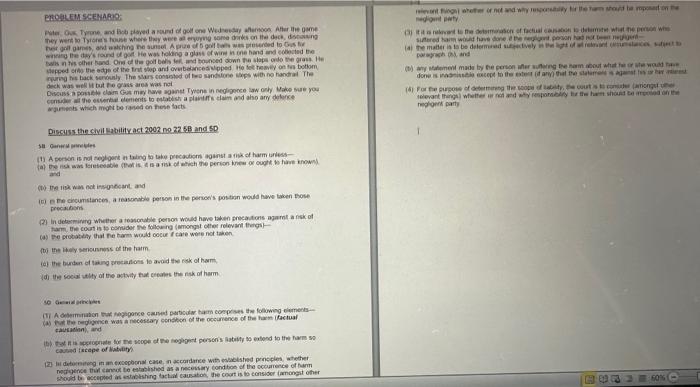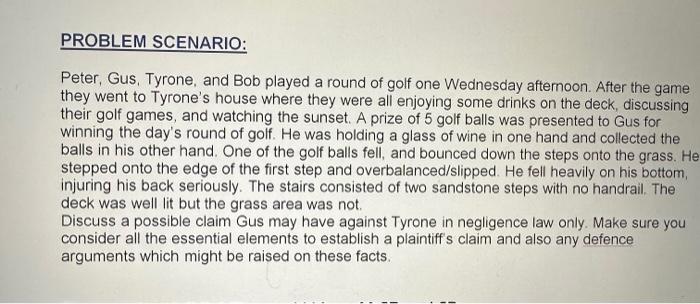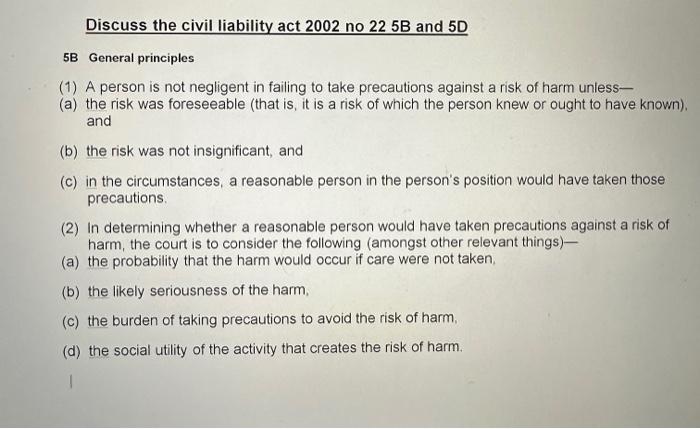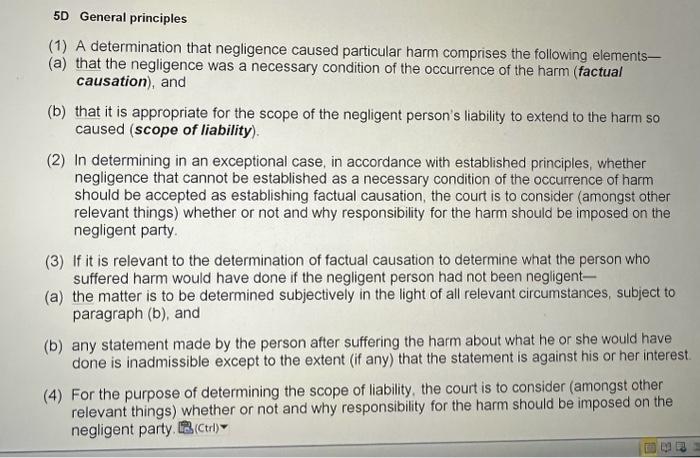Disscuss 5B and 5D in relation to the question scenario.
PTCOLEM SCFMAROQ: beck was mee in but to gask area was not Disciss the civil -abilityact 2002 no 22.5B and 5D and (w) the lise was not insindeant and precininen (7) in debermineng whiter a teasondie penon would have taken srecastons agamt a nsk of (a) tee crobutedy that he tam woid cocue f care wore not taken (ti) the Lively seriounns of the tarm (d) the soeis uthy of the artvity tud ereales the nek of herm caltakinn and cavend istape of ination PROBLEM SCENARIO: Peter, Gus, Tyrone, and Bob played a round of golf one Wednesday aftemoon. After the game they went to Tyrone's house where they were all enjoying some drinks on the deck, discussing their golf games, and watching the sunset. A prize of 5 golf balls was presented to Gus for winning the day's round of golf. He was holding a glass of wine in one hand and collected the balls in his other hand. One of the golf balls fell, and bounced down the steps onto the grass. stepped onto the edge of the first step and overbalanced/slipped. He fell heavily on his bottom, injuring his back seriously. The stairs consisted of two sandstone steps with no handrail. The deck was well lit but the grass area was not. Discuss a possible claim Gus may have against Tyrone in negligence law only. Make sure you consider all the essential elements to establish a plaintiff's claim and also any defence arguments which might be raised on these facts. 5B General principles (1) A person is not negligent in failing to take precautions against a risk of harm unless- (a) the risk was foreseeable (that is, it is a risk of which the person knew or ought to have known). and (b) the risk was not insignificant, and (c) in the circumstances, a reasonable person in the person's position would have taken those precautions. (2) In determining whether a reasonable person would have taken precautions against a risk of harm, the court is to consider the following (amongst other relevant things)- (a) the probability that the harm would occur if care were not taken, (b) the likely seriousness of the harm, (c) the burden of taking precautions to avoid the risk of harm, (d) the social utility of the activity that creates the risk of harm. (1) A determination that negligence caused particular harm comprises the following elements- (a) that the negligence was a necessary condition of the occurrence of the harm (factual causation), and (b) that it is appropriate for the scope of the negligent person's liability to extend to the harm so caused (scope of liability). (2) In determining in an exceptional case, in accordance with established principles, whether negligence that cannot be established as a necessary condition of the occurrence of harm should be accepted as establishing factual causation, the court is to consider (amongst other relevant things) whether or not and why responsibility for the harm should be imposed on the negligent party. (3) If it is relevant to the determination of factual causation to determine what the person who suffered harm would have done if the negligent person had not been negligent- (a) the matter is to be determined subjectively in the light of all relevant circumstances, subject to paragraph (b), and (b) any statement made by the person after suffering the harm about what he or she would have done is inadmissible except to the extent (if any) that the statement is against his or her interest (4) For the purpose of determining the scope of liability, the court is to consider (amongst other relevant things) whether or not and why responsibility for the harm should be imposed on the











